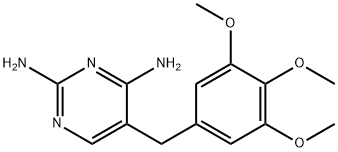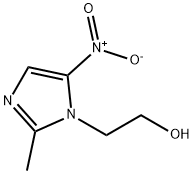A7822912
Trimethoprim , ≥99% , 738-70-5
Synonym(s):
2,4-Diamino-5-(3,4,5-trimethoxybenzyl)pyrimidine;NSC 106568
CAS NO.:738-70-5
Empirical Formula: C14H18N4O3
Molecular Weight: 290.32
MDL number: MFCD00036761
EINECS: 212-006-2
| Pack Size | Price | Stock | Quantity |
| 5G | RMB32.80 | In Stock |
|
| 25G | RMB73.60 | In Stock |
|
| 100G | RMB196.80 | In Stock |
|
| 500g | RMB626.40 | In Stock |
|
| others | Enquire |
Update time: 2022-07-08
PRODUCT Properties
| Melting point: | 199-203 °C |
| Boiling point: | 432.41°C (rough estimate) |
| Density | 1.1648 (rough estimate) |
| refractive index | 1.6000 (estimate) |
| storage temp. | 2-8°C |
| solubility | DMSO: soluble |
| form | white powder |
| pka | 6.6(at 25℃) |
| color | colorless or white |
| biological source | synthetic |
| Water Solubility | <0.1 g/100 mL at 24 ºC |
| Merck | 14,9709 |
| BRN | 625127 |
| BCS Class | 2 |
| Stability: | Stable. Incompatible with strong oxidizing agents, acids. |
| CAS DataBase Reference | 738-70-5(CAS DataBase Reference) |
| NIST Chemistry Reference | Trimethoprim(738-70-5) |
| EPA Substance Registry System | Trimethoprim (738-70-5) |
Description and Uses
Trimethoprim selectivity between bacterial and mammalian dihydrofolate reductases results from the subtle but significant architectural differences between these enzyme systems. Whereas the bacterial enzyme and the mammalian enzyme both efficiently catalyze the conversion of dihydrofolic acid to tetrahydrofolic acid, the bacterial enzyme is sensitive to inhibition by trimethoprim by up to 40,000-fold lower concentrations than the mouse enzyme is. This difference explains the useful selective toxicity of trimethoprim.
anti-inflammatory
Safety
| Symbol(GHS) |  GHS07 |
| Signal word | Warning |
| Hazard statements | H302 |
| Precautionary statements | P264-P270-P301+P312-P501 |
| Hazard Codes | T |
| Risk Statements | 25 |
| Safety Statements | 45-24/25 |
| RIDADR | 3249 |
| WGK Germany | 3 |
| RTECS | UV8225000 |
| F | 8-10-21 |
| HazardClass | 6.1(b) |
| PackingGroup | III |
| HS Code | 29335995 |
| Hazardous Substances Data | 738-70-5(Hazardous Substances Data) |
| Toxicity | LD50 orally in mice: 7000 mg/kg (Yamamoto) |



